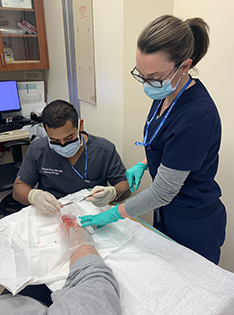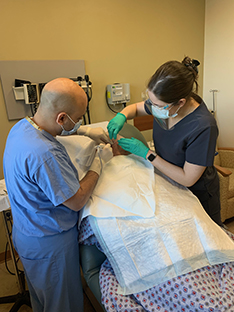Dermatologic Surgery
The Wayne State University Department of Dermatology provides its residents with broad surgical experiences throughout their training. Both general cutaneous surgery as well as Mohs Micrographic Surgery is currently being performed in our Dearborn Facility and at the John D. Dingell VA Medical Center.
Objectives
PGY-2 First year residents are expected to:
-
 Keep list of all surgical cases in which resident functions as first assistant of primary surgeon.
Keep list of all surgical cases in which resident functions as first assistant of primary surgeon. - Name the different types of anesthetics used in dermatologic surgery including the pharmacology and characteristics of the individual drugs.
- Be familiar with the commonly used suture types, their physical characteristics, and when they are appropriately used.
- List by name and function the commonly used dermatologic surgery instruments.
- Understand the appropriate care, maintenance and sterilization of surgical instruments.
- Describe the various types of biopsy techniques, the situations in which they are advantageous, and their limitations.
- Discuss the principles of cryosurgery including its utility and appropriate situations for use in destruction of lesions.
- Understand the principles of electrosurgery.
- Distinguish between electrodessication, electrocoagulation, and electrofulguration and be aware of how each is used differently.
- Be able to discuss and describe the process of wound healing as it relates to both primary closure to wounds and second intention healing.
- Be familiar with and be able to perform the technique of excision with primary layered closure.
- Become proficient in identification of basal cell carcinomas, squamous cell carcinomas, melanomas, and other cutaneous tumors.
- Understand the anatomy of the skin including superficial vessels, nerves, muscles, mucosa, nails, hair, and subcutaneous tissue.
- Understand the indications for and controversy surrounding the administration of prophylactic antibiotics in cutaneous surgery.
- Understand the indications for and controversy surrounding the discontinuation of warfarin and platelet inhibitors in cutaneous surgery.
PGY-3 Second year residents are expected to:
-
 Keep list of all surgical cases in which resident functions as first assistant of primary surgeon.
Keep list of all surgical cases in which resident functions as first assistant of primary surgeon. - Be familiar with the prognosis and biology of squamous cell carcinoma, basal cell carcinoma, melanoma, lentigo maligna, and lentigo maligna melanoma.
- Describe the technique of reconstruction of cutaneous defects with full-thickness skin grafts and split-thickness skin grafts.
- Be able to diagram the major flaps of cutaneous reconstruction including advancement, rotation, transposition flap, and pedicled flaps.
- Be competent in planning and/or performance of procedures related to minor flaps and grafts.
- Have a basic knowledge of the principles of physics that compromise lasers.
- Understand the principles of laser safety.
- Distinguish the characteristics of tissue interaction of the various lasers commonly used in dermatologic surgery.
- Describe the basic procedures of cosmetic surgeries including sclerotherapy, dermabrasion, chemical peel, etc.
- Accurately interpret frozen section histology and be able to recognize normal from pathological structures seen on frozen histology.
- List the procedures most commonly used in scar revision.
- Be able to plan and draw a scar revision utilizing Z-plasties, W-plasties, O to Z plasties, geometric broken line closures, and V to Y plasties.
- Understand the principles of tissue gain in Z-plasties and V to Y.
- List the major and minor indications for Mohs micrographic surgery (MMS) and the principles of the procedures.
- Understand the principles of micrographic tumor clearance and tissue conservation afforded by MMS.
- Be familiar with the anatomic landmark of regional and digital nerve blocks and be able to perform these under supervision.
- Be familiar with the literature that defines rational guidelines for the margin of excisions for both benign and malignant cutaneous tumors.
- Discuss the follow-up regimen for non-melanoma skin cancer and melanoma as well as the rationale for each.
- Demonstrate an understanding of coding and documentation for surgical procedures.
PGY-4 Third year residents are expected to:
-
 Keep list of all surgical cases in which resident functions as first assistant of primary surgeon.
Keep list of all surgical cases in which resident functions as first assistant of primary surgeon. - Plan and perform procedures of all major flaps and grafts involved in cutaneous reconstruction.
- Identify appropriate situations in which various techniques of reconstruction are used.
- Describe the specific management of all cutaneous malignancies.
- Be able to institute a regimen of follow-up for various cutaneous malignancies and be familiar with the literature supporting these regimens.
- Identify postoperative complications and be familiar with appropriate methods of their management.
- Describe preoperative, intraoperative, and postoperative techniques of avoiding surgical complications.
- Describe what constitutes informed consent.
- List the appropriate surgical intervention for benign and malignant tumors.
- Understand the principles and practice of cosmetic procedures.
- Be aware of selection criteria for cosmetic patients as well as risk management techniques appropriate to cosmetic surgery.
- Understand the cure rates associated with various therapeutic modalities for the treatment of basal cell carcinoma and squamous cell carcinoma.
